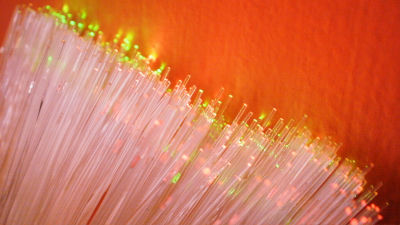Successful test of data transfer of 1 terabit per second by laser communication, possibility of eliminating the need for submarine cables

Scientists at the Zurich University of Technology in Switzerland succeeded in transferring data in units of 1 terabit per second with laser communication that connects the capital Bern to Jungfraujoch for 53 km. In the future, when laser communication using satellites is put into practical use, submarine cables may become unnecessary.
Tbit/s line-rate satellite feeder links enabled by coherent modulation and full-adaptive optics | Light: Science & Applications

Lasers enable internet backbone via satellite | ETH Zurich

Lasers enable internet backbone via satellite, may soon eliminate need for deep-sea cables
This experiment was carried out in the European-scale research and innovation funding project ` ` Horizon 2020 '', which invested 80 billion euros (about 9.8 trillion yen at the time) from 2014, and the experimental results were published in Switzerland.・Presented at the European Optical Communication Conference in Basel.
The backbone of the Internet is formed by a high-density network using optical fiber cables, and the amount of data transferred between network nodes exceeds 100 terabits per second. Continental connections are made via submarine cables, with more than 530 submarine cables spread around the world. The number of submarine cables is expected to increase further in the future. Submarine cables are expensive, and one transatlantic cable requires an investment of hundreds of millions of dollars (tens of billions of yen).
Now demonstrated by ETH Zurich, laser communications capable of transferring terabits of data could enable backbone connectivity through near-Earth satellite constellations that is more cost-effective and faster than submarine cables. increase.

Lead author of the study, Professor Janik Horst of the Institute for Electromagnetic Fields at the ETH Zurich, said: 'In optical data transfer, the test route between the Zimmerwald Observatory of the University of Bern and the Jungfraujoch High Altitude Research Station is similar to the route between the satellite and the ground station. It can be said that it is more difficult than it is,” he said.
As an Internet using satellites, Starlink etc. developed by SpaceX are known. Starlink is a service that launches 4400 satellites in low orbit to provide the Internet all over the world, and plans to launch 7500 second generation satellites. However, since microwaves with wavelengths of several centimeters are used for communication between satellites and ground stations, the speed is not so high.
On the other hand, laser communication uses near-infrared light with a wavelength of several micrometers, so more information can be transferred per unit time.
In order to maintain sufficient signal strength until it reaches a distant receiver, the laser light wave is transmitted in a modulated state from a telescope with a diameter of several tens of centimeters. The information contained is 4 bits for 16QAM and 6 bits for 64QAM .
Due to fluctuations in the turbulence of air particles, the amplitude and phase angles can add and cancel when light waves reach the detector of the receiver, giving erroneous values. ONERA introduces a micro-electro-mechanical system (MEMS) chip with 97 adjustable mirrors that deform the mirrors to modify the phase of the light wave 1500 times per second, increasing the signal strength by approximately 500 times. Improved. Professor Holst said this improvement was essential to securing 1 terabit bandwidth at a distance of 53 km.
Professor Jürg Leuthold, Director of the Institute for Electromagnetic Fields at ETH Zurich, said: 'Our system is a breakthrough. Until now, narrow bandwidths of a few gigabits were used for long-distance connections, or broadband free-space laser communications. There were only two options: connecting a short distance of a few meters with.'
This system has achieved 1 terabit per second with a single wavelength, and in the future, it is possible to easily expand to 40 terabits per second by making it 40 channels with standard technology.
Related Posts:
in Hardware, Posted by logc_nt







